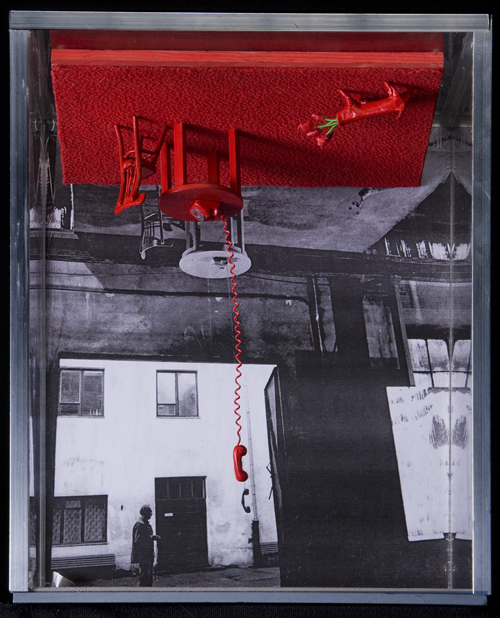Opening: Wednesday, June 27, 2012, 7 PM
The exhibition is open till September 22, Tuesday-Saturday 12 Noon-7 PM

Six Events is a reconstruction of six works by Mirosław Filonik from the period of the Neue Bieriemiennost collective (1986-1988), which he co-founded with Mirosław Bałka and Marek Kijewski. The group’s subversive appearances, with their absurd sense of humour and ephemeral objects, are more familiar from documentation than from actual works, the majority of which have not been preserved. The latter are recalled by 1:20 scale models in cabinets, in which Filonik attempts to recreate his own ephemeral sculptures and installations. The successive ‘events’, with their temporary form and provocative content, belonged to an art that functioned outside both the official and the alternative art world, in an ironic distance towards both the communist regime and the ‘Church-affiliated’ opposition movement of the era. Filonik’s sculptures and installations commented metaphorically on the realities of the late People’s Poland’s period, with its mediocrity, artificial glitter, and the early tokens of ‘plastic’ capitalism. They dealt harshly with the decadent system without, however, pinning hopes on the upcoming capitalism. Through their form and materials, such as paper, plastic or textile, they conveyed qualities characteristic for transition periods – impermanence, ephemerality, temporariness. The six events recalled in the exhibition are an attempt to recreate a fragment of an artistic phenomenon, ephemeral and not thoroughly researched, but one that has recently been more and more acknowledged and regained for the history of contemporary art and its tradition.
The show features, among other things, a reconstruction of Honolulu Baboon (1986), a mobile-sculpture installation shown for the first time at the Pracownia Dziekanka in Warsaw; a reconstruction of an installation with sculptures – Mr Francis’s Holy Birds and A Topsy-Turvy Slut (1986) – presented in the exhibition Neue Bieriemiennost for All Saints at the Galeria Wielka 19 in Poznań; a reconstruction of the installation Murder in a Red Room (1987), created for the show What’s Up at the former Norblin plant in Warsaw; and a model of the installation The Pole Eater (1987), made with Mirosław Bałka for the exhibition Neue Bieriemiennost for Jean Bedel Bokassa and presented at the Galeria Stodoła in Warsaw.
Mirosław Filonik (born 1958 in Białystok) studied sculpture in the Warsaw Academy of Fine Arts (1980-1985), where he met Mirosław Bałka and Marek Kijewski, the three eventually forming the collective Neue Bieriemiennost. Filonik graduated under Prof Jan Kucz with an Untitled project, an installation in an abandoned house in a village near Warsaw. Until 1988, he worked as part of Neue Bieriemiennost, exhibiting his most important works of the period with the rest of the group: 1,000 Yellow Hands, The Swing, Honolulu Baboon, Neue Bieriemiennost for All Saints (all 1986), The Palace Eater (1987) and Ich bin Wolf (1988) (both with Mirosław Bałka), or Murder in the Red Room as part of the famous show What’s Up (1987). In the late 1980s, Filonik started creating installations using fluorescent lights, the first being Untitled in the exhibition Feelings (1989). Since then he has created several dozen installations that employ light and the symbolism of geometric forms and signs, e.g. The Cross at the New Art Biennale in Zielona Góra, then shown in Kotka (Finland) and Hamburg (1990); Daylight at the Art Hotel festival in Łódź (1990) and at the Zachęta National Gallery of Art in Warsaw (1993); Blue Light System on the Białystok University building (1995); or Daylight System on the Królikarnia building in Warsaw (1996) and on the towers of the Ujazdowski Castle in Warsaw (1997).


